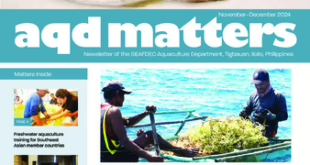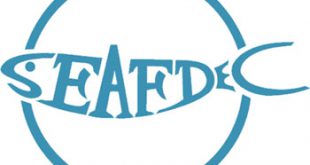| Substrate matters |
| Even bottom feeders like abalone know the importance of good substrates |
| Marine invertebrates use a range of physical, biological and chemical signals to influence their metamorphosis and larval settlement. In the abalone hatchery environment, these could include food sources and appropriate substrates.
To determine what combination of substrate and food source is best for abalone larvae, Rolando Gapasin and Bernice Polohan of SEAFDEC/AQD subjected Haliotis asinina postlarvae to different “substrate-diatom” complexes, together with gamma-aminobutyric acid or GABA. Substrates made of plexiglass, rubberized canvas, fibrocement board and corrugated plastic were placed on the floor bottom of four plexiglass aquaria. Each of these were then inoculated with the following diatom species: Amphora sp., Nitzchia cf. frustulum, a 1:1 combination of Amphora and Nitzchia, and diatom “slurry” composed of Amphora, Coscinodiscus, Coconeis, Nitzchia, Diploneis and Mastolia.
Based on the results of two trials, abalone larvae apparently preferred their diatom slurry served over roughened plexiglass in combination with GABA; around 27% and 20%, respectively, of abalone larvae metamorphosed using this combination of substrate-diatom complex. The others did not fare as well: among the diatoms, Nitzchia cf. frustulum gave the lowest percentage of metamorphosed larvae, while fibrocement was the lowest-testing of the four substrates.
What accounted for the difference? The proponents speculate that the amount of extracellular substances produced by Nitzchia cf. frustulum may not have been enough to sustain the abalone postlarvae. This species may have exhibited low digestion efficiency, or that sub-optimal culture conditions may have contributed to poor growth of the diatom, which led to poor settlement and metamorphosis of the abalone. Also, since it was found that postlarvae preferred crustose coraline algae together with its associated benthic diatoms in their natural habitat, the roughened plexiglass was probably the next best thing in a culture setting.
The results given should serve as cues for abalone postlarvae growers to make modifications if necessary to ensure optimum growth of their stocks.
Read more of this research from the journal Hydrobiologica (2005) 548:301-306. |
Check Also
2023 Releases
September-October 2023Download here — File Size: 7.85 Mb July-August 2023Download here — File Size: 5.17 …
 SEAFDEC/AQD Southeast Asian Fisheries Development Center | Aquaculture Department
SEAFDEC/AQD Southeast Asian Fisheries Development Center | Aquaculture Department

